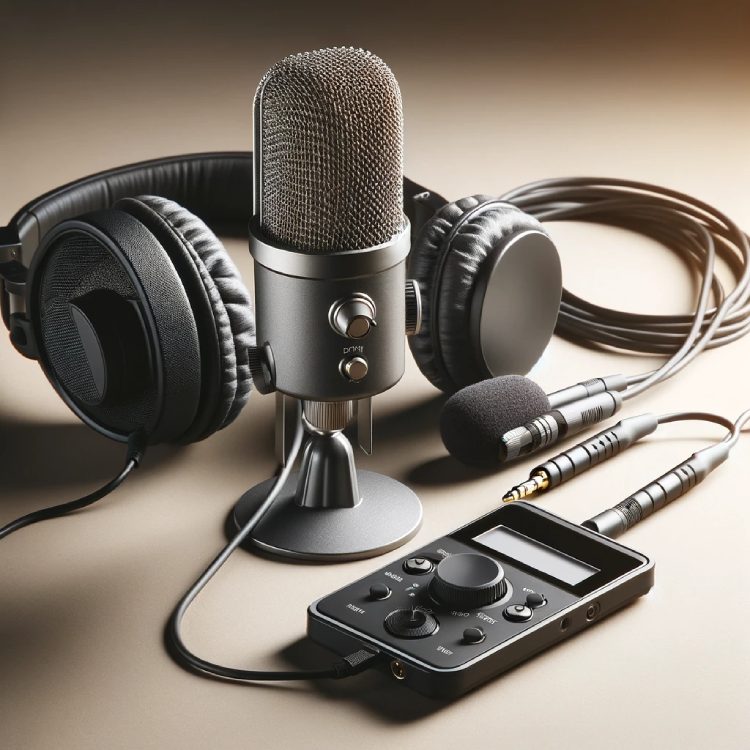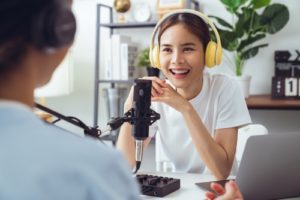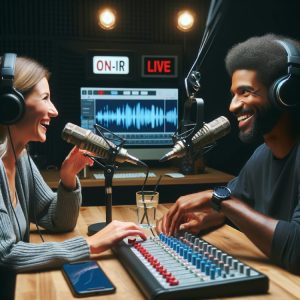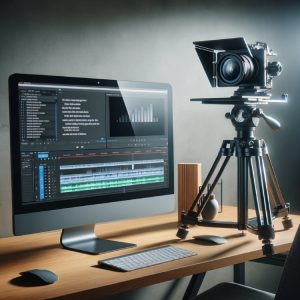 When producing a podcast, several elements are important to consider as you pull together podcasting equipment. It is paramount for independent to large network-sized podcasters to make informed choices while assembling their podcasting gear. Naturally, there are many approaches to compiling a podcast equipment list, each with its unique merits and constraints, to employ the best-fitted tools for individual needs and preferences.
When producing a podcast, several elements are important to consider as you pull together podcasting equipment. It is paramount for independent to large network-sized podcasters to make informed choices while assembling their podcasting gear. Naturally, there are many approaches to compiling a podcast equipment list, each with its unique merits and constraints, to employ the best-fitted tools for individual needs and preferences.
One of the key elements is to sound good without spending too much money. In the early days of podcasting, only high-end professional gear was available. Today, there are a myriad of options that will fit almost any budget. New podcasters should be mindful of purchases to have the equipment they use versus equipment that gets left in a box.
When procuring the podcasting equipment, keep in mind you are setting the stage for a compelling experience for the listener. From microphones that capture every syllable with clarity to headphones offering precision in sound detection, from an audio interface that connects your gear, translating analog signals to digital and vice versa, to a pop filter that diffuses sound blasts caused by natural speech, the roster of essentials graces an expansive landscape in podcast production.
Podcasters are exploring the flexibility of recording outside the confines of a traditional studio setup. This includes portable digital recorders, lavalier microphones, and foldable acoustic treatments, to name a few, aiding in capturing sound anytime, anywhere, with minimal compromise on quality. With advances in technology and software development, the podcasting toolbox now includes podcasting equipment and software.
Also, digital audio workstation (DAW) software aids in recording, editing and producing the podcast and hosting platforms, which facilitate the publishing and distribution of the podcast to various platforms.
Specifically tailored to meet the needs of budding and seasoned podcasters alike, Blubrry offers discerning insights and support, helping creators navigate the universe of podcasting equipment. Knowing the right tools is just the beginning of creating your unique imprint on the canvas of sound.
Beginner Podcasting Equipment
 Setting up your first podcasting station can be an adventurous and exciting process. The term “beginner podcasting equipment” may give the impression of basic, low-quality gear, but this does not have to be true. Even as a novice in the field of podcasting, investing in good quality equipment can immensely augment the production value of your podcast, lending it an air of professionalism and competence that can attract and maintain a larger audience base.
Setting up your first podcasting station can be an adventurous and exciting process. The term “beginner podcasting equipment” may give the impression of basic, low-quality gear, but this does not have to be true. Even as a novice in the field of podcasting, investing in good quality equipment can immensely augment the production value of your podcast, lending it an air of professionalism and competence that can attract and maintain a larger audience base.
So, what does podcasting equipment for beginners typically consist of? Although the specifics can vary based on personal preferences and budget, a standard podcasting equipment kit includes the following:
- Microphone: A quality microphone is crucial for clear audio recording. Dynamic microphones are popular for being forgiving in a noisy environment.
- Headphones: Closed-back, over-ear, or in-ear headphones are recommended for monitoring audio during recording.
- Audio Interface: This device connects your microphone to your computer, converting the analog signal to digital. USB Microphones are quite the rage now for solo podcasters.
- Pop Filter or Windscreen: Helps reduce plosive sounds (like “p” and “b”) and protects the microphone from saliva.
- Boom Arm or Mic Stand: Supports the microphone at the right position and angle for recording.
- Shock Mount: Reduces handling noise and vibrations that could affect the microphone.
- Recording Software: A digital audio workstation (DAW) for recording and editing your podcast. Examples include Audacity, Hindenburg, Descript, or Adobe Audition.
- Acoustic Treatment: Optional but beneficial, it includes items like foam panels to improve the sound quality of your recording environment.
- Portable Recorder: Handy for on-the-go or field recordings (optional but helpful for specific podcast formats).
- Cables and Connectors: XLR or USB cables, depending on your equipment setup.
Remember, the specific choices within each category depend on your budget, podcast format and personal preferences. Many podcasters start with just a handheld USB microphone and mic stand. Review this Podcast Insider blog on podcasting equipment for more tips and insights.
Investing in a podcast equipment bundle streamlines this process. Setting up podcasting equipment involves several key steps wherever you decide to start.
- First, connect your microphone to your audio interface, whether directly to your computer or through a device like the Rodecaster,
- Ensure the microphone is secured in place with the stand or boom arm.
- Next, position the pop filter in front of the microphone – this will help soften the impact of plosive sounds during recording.
- For the final step, plug in your headphones, ideally into the headphone input on your audio interface or even sometimes a connector on the mic itself, to ensure accurate monitoring.
However, if you prefer to start as minimal as possible, you can set up a basic podcast setup from your smartphone. A setup like this will offer different audio quality or professionalism, yet can be a stepping stone to familiarize yourself with the process and gain confidence.
The format of your podcast will often drive decisions on gear; if you have a remote co-host, the considerations grow but are not at all complex and are simple to put together. The team here at Blubrry can walk you through your options before you spend money you may not need to spend.
The realm of podcasting is vast, with opportunities for storytelling, sharing knowledge, networking and forging connections with diverse listeners worldwide. Whether you invest in a beginner podcasting equipment kit or a full-blown professional-grade podcast equipment bundle, the experience promises to be memorable and gratifying. So gear up and let your voice echo across the global airwaves.
Video Podcast Equipment
 As leaders in the podcasting world, Blubrry provides a broad spectrum of services. These include hosting and crucial analytics to podcasters, big and small. With an evolving technological landscape, the popularity of video podcasts has surged. An increasingly dedicated viewership has found resonance with video content that brings visual aid to audio storytelling.
As leaders in the podcasting world, Blubrry provides a broad spectrum of services. These include hosting and crucial analytics to podcasters, big and small. With an evolving technological landscape, the popularity of video podcasts has surged. An increasingly dedicated viewership has found resonance with video content that brings visual aid to audio storytelling.
It’s a common misconception that posting a video on YouTube is considered a video podcast. For it to be considered a podcast, the video needs an RSS feed that allows dissemination onto other platforms such as Apple Podcasts, Spotify and iHeart Radio. Blubrry’s Vid2Pod video-to-podcast feature enables video-first creators to automatically convert their work into an audio podcast.
However, video podcasting introduces a few unique challenges and equipment requirements compared to audio-only podcasting. The heart of any podcast, audio or video, is the stories being shared and the conversations that unfold. A podcast can range from solo commentaries to interviews or panel discussions. Regardless of your format, a critical piece of podcasting equipment is the microphone for capturing clear and high-quality audio, which is essential for any podcast. Audio-only podcasters can dedicate their resources to purchasing great microphones and audio-mixing equipment. In contrast, video podcasters have to account for the visual elements.
This brings us to the video podcast equipment. In addition to a good microphone, video podcasters require cameras capable of capturing high-definition footage. Tripods or other stabilizing devices are essential to reduce camera shake and ensure a steady focus on the host and guests. Podcasters often prioritize lighting to give the video a professional look. Three-point lighting can eliminate harsh shadows and showcase the host and guests in a flattering light. Creating a video podcast requires careful attention to the shooting location as well. The background or set contributes to the viewer’s experience and can reinforce the podcast’s theme or mood.
Video podcasting equipment selections will also depend on where you will be recording. Fixed placement in a bedroom or den is more straightforward to plan for than shooting a show remote; the gear requirements are different. Our founder often watched other shows to see what they used and the setup they used to drive his purchase decisions. You can see his full studio gear list here.
Live podcasting equipment requirements further expand what is needed. Before embarking on a live podcast, read up on the pros and cons of going live. A fast and reliable internet connection is mandatory to avoid disruptions during the live stream. Depending on the complexity of the podcast, hardware or software for live switching between different camera angles might be necessary.
Having a technology partner that supports video and audio podcasting can ease many of these challenges. Blubrry’s suite of services is designed to work seamlessly with video and audio content, offering a smooth experience for the podcaster and their audience. Setting up your podcasting equipment properly contributes to a more straightforward production process and a better viewing or listening experience for your audience. Whether you’re producing an audio-only podcast, a fully visualized video podcast, or streaming live to your audience with Blubrry, you’re in great hands.
Best Podcasting Equipment
Exploring the domain of podcasting, many essential factors that genuinely contribute to creating a high-quality podcast that resonates with audiences come to fruition. Undoubtedly, one of the most meaningful aspects to consider is, beyond any shred of doubt, owning the best podcasting equipment.
 With an intricate balance of technical properties and comfort, it is crucial to find podcasting equipment that provides an immaculate audio experience for the audience while minimizing the complexity of use for the podcasters. Diving deeper into this topic, a list worth noting is the podcasting equipment list (see above). It entails specific equipment required for creating a professional-grade podcast without pinpointing any particular model or brand.
With an intricate balance of technical properties and comfort, it is crucial to find podcasting equipment that provides an immaculate audio experience for the audience while minimizing the complexity of use for the podcasters. Diving deeper into this topic, a list worth noting is the podcasting equipment list (see above). It entails specific equipment required for creating a professional-grade podcast without pinpointing any particular model or brand.
A standard list would typically include a microphone, headphones, a mixer, a pop filter, an audio interface, and a sturdy microphone stand. Of course, obtaining a high-quality device from each category remains paramount for any podcaster striving for pristine sound quality. As we move along the spectrum of additional podcasting bells and whistles, an exciting area worth noting would be the best podcast equipment bundles. These multipurpose packs usually come with all the essential components, often at a more cost-effective range compared to buying each tool separately. However, deciphering the best bundle mainly depends on the specific requirements of the podcaster considering the purchase.
Speaking of requirements, let’s delve into another topic: essential podcasting equipment – items that even a modest, entry-level podcaster cannot go without. This typically includes a high-quality USB or XLR microphone, over-ear headphones to monitor audio, and a soundproof recording space to ensure crisp, clear and noise-free podcasts. However, for podcasters seeking to make their mark in the industry, merely having the essentials may not suffice. This is where professional podcasting equipment takes into the picture, significantly elevating the podcast’s audio quality.
Elevating the essence of audio clarity, these advanced tools provide greater flexibility and control over the sound. As with essentials, a professional podcasting setup should ideally include studio-grade microphones, top-notch headphones, high-end mixers, robust microphone stands, and advanced software to refine the audio. Choosing good podcasting equipment — one that guarantees the utmost audio quality while aligning with the podcaster’s preferences and needs — is an avenue that demands time, research and a considerable degree of familiarity with the best podcasting equipment.
As long as ambitious podcasters equip themselves with the right knowledge, choose tools cautiously and remain dedicated to consistently delivering high-quality audio, there’s no stopping them from taking their podcasting endeavors to uncharted heights. To get started with Blubrry, sign up for an account today. Happy podcasting!




